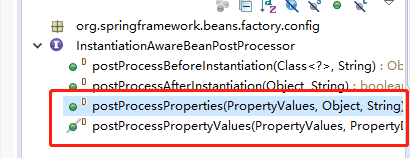前面介绍了InstantiationAwareBeanPostProcessor后置处理器的postProcessBeforeInstantiation和postProcessAfterInstantiation两个方法的用法和使用场景等。在InstantiationAwareBeanPostProcessor中还有两个方法,分别是postProcessProperties和postProcessPropertyValues,从这两个方法的名称上来看,它们完成的功能似乎很相近,下面来看具体的方法。
一、概述
在InstantiationAwarePostProcessor接口中的两个方法如下,

二、详述
在InstantiationAwareBeanPostProcessor接口中找到两个方法的定义如下,
/** * Post-process the given property values before the factory applies them * to the given bean, without any need for property descriptors. * <p>Implementations should return {@code null} (the default) if they provide a custom * {@link #postProcessPropertyValues} implementation, and {@code pvs} otherwise. * In a future version of this interface (with {@link #postProcessPropertyValues} removed), * the default implementation will return the given {@code pvs} as-is directly. * @param pvs the property values that the factory is about to apply (never {@code null}) * @param bean the bean instance created, but whose properties have not yet been set * @param beanName the name of the bean * @return the actual property values to apply to the given bean (can be the passed-in * PropertyValues instance), or {@code null} which proceeds with the existing properties * but specifically continues with a call to {@link #postProcessPropertyValues} * (requiring initialized {@code PropertyDescriptor}s for the current bean class) * @throws org.springframework.beans.BeansException in case of errors * @since 5.1 * @see #postProcessPropertyValues */ @Nullable default PropertyValues postProcessProperties(PropertyValues pvs, Object bean, String beanName) throws BeansException { return null; }
上面的是postProcessProperties方法,我这里贴出了方法的注释,从注释中我们可以看出该方法从5.1版本后才有。下面看postProcessPropertyValues方法,
/** * Post-process the given property values before the factory applies them * to the given bean. Allows for checking whether all dependencies have been * satisfied, for example based on a "Required" annotation on bean property setters. * <p>Also allows for replacing the property values to apply, typically through * creating a new MutablePropertyValues instance based on the original PropertyValues, * adding or removing specific values. * <p>The default implementation returns the given {@code pvs} as-is. * @param pvs the property values that the factory is about to apply (never {@code null}) * @param pds the relevant property descriptors for the target bean (with ignored * dependency types - which the factory handles specifically - already filtered out) * @param bean the bean instance created, but whose properties have not yet been set * @param beanName the name of the bean * @return the actual property values to apply to the given bean (can be the passed-in * PropertyValues instance), or {@code null} to skip property population * @throws org.springframework.beans.BeansException in case of errors * @see #postProcessProperties * @see org.springframework.beans.MutablePropertyValues * @deprecated as of 5.1, in favor of {@link #postProcessProperties(PropertyValues, Object, String)} */ @Deprecated @Nullable default PropertyValues postProcessPropertyValues( PropertyValues pvs, PropertyDescriptor[] pds, Object bean, String beanName) throws BeansException { return pvs; }
从上面可以看出该方法上已经被标记为@Deprecated即为废弃的,且是从5.1开始才被废弃的。也就是说从5.1开始均使用postProcessProperties方法。
既然,在5.1之后postProcessPropertyValues方法已废弃,使用的postProcessPropertiesf方法,那么他们的功能肯定是一样的,那么就只看postProcessProperties方法即可。
postProcessProperties方法要完成的工作是处理类中的属性,并为属性赋值,在spring中已经有相应的实现,CommonAnnotationBeanPostProcessor和AutowiredAnnotationBeanPostProcessor两个实现便可以完成这些工作。这里就不再列举详细的使用方式,下面会具体分析CommonAnnotationBeanPostProcessor和AutowiredAnnotationBeanPostProcessor两个实现类的具体实现,以及这两个类分别完成的功能。
三、使用场合
如果需要使用自定义的spring框架,在进行属性注入的时候不想使用spring的方式,这里可以选择实现InstantiationAwareBeanPostProcessor接口,实现postProcessProperties方法,自己实现属性注入的方式。不过最好还是使用spring内部已经实现好的类。